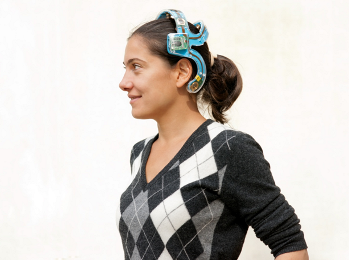Imec, Holst Centre and Panasonic have developed a new prototype of a wireless EEG (electroencephalogram) headset.
The system combines ease-of-use with ultra-low power electronics. Continuous impedance monitoring and the use of active electrodes increases the quality of EEG signal recording compared to former versions of the system. The data are transmitted in real-time to a receiver located up to 10m from the system. The realization of this prototype is a next step towards reliable high-quality wearable EEG monitoring systems.
The system integrates circuit level components including imec’s active electrodes and EEG amplifier together with a microcontroller and a low power radio. It is capable of continuously recording 8 channel EEG signals while concurrently recording electrode-tissue contact impedance (ETI). This simultaneous ETI recording enables continuous, remote assessment of electrode contact status during EEG recording. The active electrodes reduce the susceptibility of the system to power-line interference and cable motion artifacts, thus improving signal quality. The system can be configured at run-time to change the settings of the recordings such as the number of channels, or enabling/disabling the impedance recording. The autonomy of the system ranges from 22 hours (8 channels of EEG with ETI) to 70 hours (1 channel of EEG only).
The system has a high common-mode rejection ratio (>92 dB), low noise (<6 µVpp, 0.5-100Hz), DC offset tolerance of +/- 900mV and is AC coupled with configurable cut-off frequency. Sensitivity and dynamic range are configurable through a programmable gain stage (default 1.5mVpp and 366nV, respectively).The system (with dry electrodes and no skin preparation) is validated against a commercially available wired reference system (with wet electrodes and skin preparation), comparing the spectra between 1 and 30Hz. The high correlation coefficients (ranging from 0.81to 0.98 in four 1-minute recordings with eyes open) indicate that both systems have similar performance.
The heart of the system is the low-power (750µW) 8-channel EEG monitoring chipset. Each EEG channel consists of two active electrodes and a low-power analog signal processor. The EEG channels are designed to extract high-quality EEG signals under a large amount of common-mode interference. The active electrode chips have buffer functionality with high input impedance (1.4GÙ at 10Hz), enabling recordings from dry electrodes, and low output impedance reducing the power-line interference without using shielded wires.
The system is integrated into imec’s EEG headset with dry electrodes, which enables EEG recordings with minimal set-up time. The small size of the electronics system, measuring only 35mm x 30mm x 5mm (excl battery), allows easy integration in any other product.
Industry can get access to imec’s technology for intelligent body area networks with wireless sensors, such as this EEG, by joining imec’s Human++ program as research partner or by licensing agreements for further product development. Within the Human++ program, imec and Holst Centre develop solutions for an efficient and better healthcare.
 Image credit: Imec. Wireless Low-power Active-Electrode EEG Headset.
Image credit: Imec. Wireless Low-power Active-Electrode EEG Headset.
About imec
Imec performs world-leading research in nanoelectronics. Imec leverages its scientific knowledge with the innovative power of its global partnerships in ICT, healthcare and energy. Imec delivers industry-relevant technology solutions. In a unique high-tech environment, its international top talent is committed to providing the building blocks for a better life in a sustainable society. Imec is headquartered in Leuven, Belgium, and has offices in Belgium, the Netherlands, Taiwan, US, China, India and Japan. Its staff of close to 2,000 people includes more than 600 industrial residents and guest researchers. In 2011, imec's revenue (P&L) was about 300 million euro. Further information on imec can be found at www.imec.be.
Imec is a registered trademark for the activities of IMEC International (a legal entity set up under Belgian law as a "stichting van openbaar nut”), imec Belgium (IMEC vzw supported by the Flemish Government), imec the Netherlands (Stichting IMEC Nederland, part of Holst Centre which is supported by the Dutch Government), imec Taiwan (IMEC Taiwan Co.) and imec China (IMEC Microelectronics (Shangai) Co. Ltd.) and imec India (Imec India Private Limited).
About Holst Centre
Holst Centre is an independent open-innovation R&D centre that develops generic technologies for Wireless Autonomous Transducer Solutions and for Systems-in-Foil. A key feature of Holst Centre is its partnership model with industry and academia around shared roadmaps and programs. It is this kind of cross-fertilization that enables Holst Centre to tune its scientific strategy to industrial needs.
Holst Centre was set up in 2005 by imec (Flanders, Belgium) and TNO (The Netherlands) with support from the Dutch Ministry of Economic Affairs and the Government of Flanders. It is named after Gilles Holst, a Dutch pioneer in Research and Development and first director of Philips Research.
Located on High Tech Campus Eindhoven, Holst Centre benefits from the state-of-the-art on-site facilities. Holst Centre has over 150 employees from around 25 nationalities and a commitment from more than 30 industrial partners.
Visit us at www.holstcentre.com